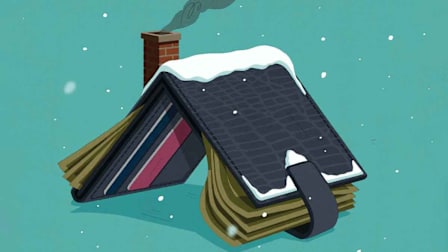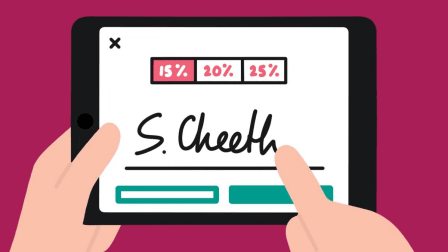How to Tip With More Confidence
Fast-food counters. Coffee spots. Even convenience stores. It seems like we're being asked for gratuities everywhere. Here's when you don't have to pay, when you might want to, and how much.
Perhaps you’ve stumbled into this scenario: At an airport, scrambling to buy a snack and a bottle of water before a flight, you find the checkout kiosk and tap your card. The machine asks if you’d like to add a tip. But . . . for whom? The employee in the corner hanging bags of Cheez-Its?
Or maybe you’ve had this experience: You’re at a trendy restaurant where you go to a counter to order food that will be brought to your table—after you collect your own silverware. When you’re asked to pay, the counter person spins a screen to reveal tip increments of 20, 25, and 30 percent . . . for service on food and drinks you haven’t even received yet.
Welcome to the new normal in tipping: being put on the spot to leave a gratuity in situations you never used to be. It can be confusing and frustrating—not to mention guilt-inducing—especially if there are prying eyes behind you in line watching what you select on the screen.
And we’re not only being asked to tip more often. There’s also what’s known as “tipflation”—where we’re being asked to tip in higher amounts. A December 2023 nationally representative Consumer Reports survey (PDF) of 2,027 U.S. adults found that 64 percent said they were being asked to tip “much” or “somewhat” more often than they were five years ago. And over half said they felt they’d been pressured to leave a bigger tip than they wanted to. (Take our poll on tipping, below.)
“Tipping is broken,” says Harlan Scott, a hospitality consultant and restaurateur in Austin, Texas. “You often don’t know if you’re tipping to give an employee making twenty dollars an hour a little bonus or if you need to tip to subsidize someone being paid a minimum wage.” Also unclear: Whether the person you’re tipping gets traditional benefits through their employer. “It’s a tremendous amount of pressure on the consumer.”
Dining-Out Etiquette
Signing a restaurant bill isn’t straightforward anymore. A tip of 15 to 20 percent or higher (before tax) for exceptional service is still standard. But what if you bus your own table?
Illustration: Domenic Bahmann Illustration: Domenic Bahmann
A Tip Line on the Receipt Has Been Added Even Though You’ve Already Been Charged a Gratuity
Scenario: The bill for your group dinner includes a 20 percent auto-gratuity. Yet on the receipt, there’s a handwritten “thanks” from your server and a line for an additional tip. Isn’t the auto-tip enough?
The move: Unless your service was truly exceptional, leave it as is. “You are not obligated to tip extra,” Whitmore says.
You Get Partial Service
Scenario: At a casual eatery, you order at a counter but are served at a table. The payment screen asks for a tip at the time of ordering. How much for this half-self, half-served experience?
The move: Consider tipping a midrange amount—perhaps 10 percent—that reflects the hybrid nature of the service experience.
You’re Asked for a Tip When Picking up Fast Food
Scenario: You’re collecting your order at the counter when a staff member spins the screen, suggesting a 20 percent tip for handing over your pizzas and salad.
The move: When minimal service is involved, consider a few bucks or none at all. “You won’t be alone. Recent surveys have shown that around 40 percent of consumers tip for a food pickup,” Lynn says. “That’s not a majority. You don’t have to submit to pressure as much as you think.”
You're Ordering With a QR Code
Scenario: At a new restaurant, you order and pay with a QR code instead of dealing with a waiter—but are then asked for a tip.
The move: As with counter service, make a judgment call and tip only for the actual service level you receive. (Is the food delivered to you? Did you have to set up and clear your own table?) “You might want to give the waiter something, but it’s not going to be 20 percent of the entire bill,” says Diane Gottsman, an etiquette expert. “It’s more of what you feel is appropriate.”
You’re Asked to Pay a Tip on Top of a Service Charge
Scenario: Your meal concludes and the bill lists a service charge. There’s also a line to add a tip. Isn’t a service charge the same thing as a tip?
The move: Ask your server to clarify what the service charge is for. “Service charges aren’t one-size-fits-all,” Gottsman says. Some may be to offset the expense of operating a restaurant. But “some may go to the server. Since it involves their livelihood, most will be happy to tell you the details.”
You Wonder if a Dollar Tip Is Enough for a Cocktail
Scenario: At an upscale bar, specialty cocktails are priced at $16, leaving you questioning the old dollar-per-drink rule.
The move: Consider the craftsmanship involved. (Did the bartender just spear a bunch of fruit and shake up the drink for a minute?) Adjust your tip to up to 20 percent of your bill depending on the bartender’s skill and effort. But the dollar-per-drink rule generally holds if you’re having, say, a glass of wine or a beer.
Food Deliveries
Delivery apps make getting food easy, but figuring out tips? That’s the tricky part.
You Can’t Tell if the Delivery Fee Is the Same as a Tip
Scenario: You’re shopping online for groceries or takeout and see a delivery fee at checkout. You wonder if it includes a tip.
The move: Delivery and service fees usually aren’t treated as tips for the driver. “Always check the website or app,” says Gottsman, who adds that a tip of 15 to 20 percent of the total bill, or a minimum of $5 if it’s a small order, is usually appropriate.
You Prepaid the Tip
Scenario: You’ve already added a tip during the checkout process on a delivery app. When your food arrives, does this mean that no extra cash handoff is needed at the door?
The move: If you’ve tipped through the app, you’re all set. These amounts go directly to your delivery person, so no need to fumble for cash at the door. If you tipped through the app but still want to make sure the gratuity truly goes to the driver, check the app’s FAQs or ask when the delivery person arrives. Most delivery apps are transparent about their policies.
In-Home Services
Deciding whether to give a gratuity for a home service—from a sofa delivery to a stove fix—can be a head-scratching experience. When should you grease a palm and when will a simple thanks do?
They’re Setting up a New Sofa
Scenario: After paying a hefty delivery fee for your new sofa, you wonder if tipping the delivery team is expected or necessary.
The move: Even with substantial delivery fees, acknowledging the physical effort of a delivery team with a small tip of $5 to $10 per person is a kind gesture. “The more stairs, the higher the tip,” suggests Jodi RR Smith, an etiquette consultant.
Your Building Handyman Unclogs Your Drain
Scenario: When someone on the maintenance staff of your building or homeowners association comes to fix a toilet or tighten a hinge, should you hand over a little extra?
The move: In general, you should be tipping maintenance employees you regularly deal with at the end of the year. But when the service goes above and beyond, a tip on the spot can express your gratitude more personally. “Especially if it’s in the middle of the night or on a major holiday,” Smith says.
The Repair Is Pricey
Scenario: A technician charges $400 for an essential repair. Given the high cost, do you still need to tip?
The move: “Generally, skilled technicians and tradespeople like plumbers are not tipped, but it’s situational,” Smith says. If the person went above and beyond, was professional, and solved a significant problem, a tip of $10 to $20 might be a way to say thank you, though it’s not obligatory, given the high initial cost, she says.
Self-Care
At a salon or medi-spa, the only thing more complex than choosing the right kind of facial is figuring out the tipping protocol. Who knew relaxation could be so stressful?
You’re Getting Your Hair Cut by the Owner
Scenario: After a satisfying haircut at the salon, you wonder whether to tip the stylist, who happens to be the owner.
The move: “Etiquette has evolved here,” Smith says. She advises tipping your stylist every time you visit even if they’re the owner. Fifteen to 20 percent is still the standard, according to Gottsman.
Your Derm Does a Skin Check
Scenario: You’re at a dermatologist’s office that also offers cosmetic treatments, but you’re there to get a spot on your skin evaluated. When you’re leaving, a tipping option appears on the payment screen, leaving you uncertain.
The move: It’s generally accepted that you don’t tip a dermatologist—just as you wouldn’t tip any other doctor, or an attorney.
Hired Cars
Ride-hailing services like Uber and Lyft have brought added tipping twists to figure out.
You Don’t Know Whether to Tip the Uber Driver
Scenario: At the end of a trip, an app prompts you for a tip. But you remember a time when tipping wasn’t an option, and you’re unsure about the current expectations.
The move: You’re right. Uber, for instance, didn’t allow tipping until 2017. But today, tipping 15 percent as a baseline—with room to increase for exceptional service—is appropriate. “It’s crucial to remember that ride-share drivers often don’t have the benefits that come with traditional employment,” Smith says.
You’re Taking a Taxi, Not an Uber
Scenario: You’ve just arrived at your destination via a taxi you hailed on the street. But have new practices influenced tipping norms for cabs?
The move: “The standard for tipping cab drivers remains at about 15 percent,” Smith advises. If the tip screen you see starts with higher options, feel free to enter a custom amount. But “consider more if it’s a very short trip or it’s raining, or if they’ve taken you a long way to a place where they’re unlikely to pick up another fare.”
Hotels and Travel
What’s the right way to tip someone who works behind the scenes? And what if you forget cash at the valet stand?
You’re Traveling With Your Messy Family
Scenario: You’re getting ready to check out of your hotel and you think about the housekeeping staff cleaning up after you and your two young kids. Should you leave a bigger tip for the extra mess?
The move: Yes. “Start with $3 to $5 per day, and with each extra guest add $1 per person to cover the additional effort,” Whitmore says. “Tip daily instead of at the end, since housekeeping staff may change.”
You’re Paying for Room Service
Scenario: You’re signing for your room-service meal, noticing the menu mentioned that gratuity was included, yet there’s still a line for an extra tip. Now you’re puzzled.
The move: “Always start by reviewing your bill to confirm that the gratuity was included” as the menu indicated it would be, Gottsman says. “If not, a tip of 15 to 20 percent of the bill is appropriate. You don’t need to tip again for tray pickup.”
Your Concierge Gives You Easy Directions
Scenario: After asking the hotel concierge for directions to the best nearby coffee shop, you wonder if this simple request merits a tip.
The move: “For quick directions to the nearest coffee shop, no tip is required,” Gottsman says. “But for services like snagging theater tickets or dinner reservations, tip $5 to $10. For helping you snag hard-to-get tickets or bookings, $20 or more is appropriate.”
You’re Not Sure What to Tip the Luggage Attendant
Scenario: They help with your suitcases, and you have a couple. You’re wondering how much to tip for this brief yet helpful service.
The move: Typically, the tip is $1 to $2 per bag. But if you have just one or two, a $5 tip might be more appropriate. A rule that Gottsman follows is “if they touch it”—meaning bags, extra pillows, etc.—take that as a sign that it’s a good time to tip.
You’re Out of Cash
Scenario: You’re at the valet stand, ready to drive off, when you realize your wallet’s empty of the standard tip ($2 to $5). Do you ask the person who just retrieved your car if they would accept Venmo or another type of mobile payment in place of a cash tip?
The move: Sure. The digital era has made this question more acceptable. “I would strongly encourage it,” Smith says.
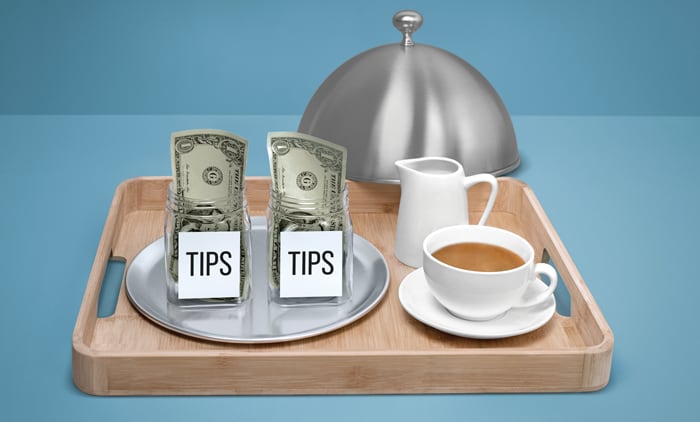
- Restaurant Server: 15% to 20%
- Hair Stylist or Barber: 15% to 20%
- Manicurist: 15% to 20%
- Taxi and Ride-Hail: 15% to 20%
- Bartender (per drink): $1 or 20%
- Barista: 15% to 20%
- Delivery Person: 10% to 15%
- Taxi and Ride-Hail: 15% to 20%
- Delivery Person: 10% to 15%
- Coat Checker (per coat): $1 to $5
- Mover (per person): $20 to $50
- Appliance/Furniture Deliverer: $10 to $20
- Valet: $2 to $5
- Hotel Housekeeper: $3 to $5 per day
- Hotel Bellhop (per bag): $2 to $5
- Hotel Concierge (for special services): $20 to $100
Editor’s Note: This article also appeared in the July 2024 issue of Consumer Reports magazine.


















